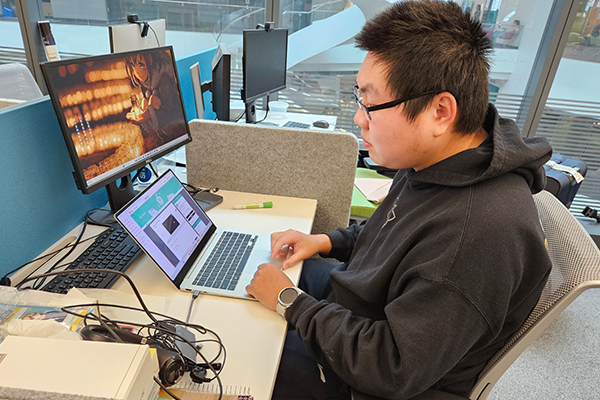MS to PhD Research Leads to Improved Autonomous Vehicles

Xiangyu Bai, MS’23, electrical and computer engineering, who is now pursuing his PhD at Northeastern in computer engineering, conducts research in the area of computer vision focused on improving autonomy simulations. He is advised by Associate Professor Sarah Ostadabbas and works in her Augmented Cognition Laboratory. He co-authored “Bridging the Domain Gap between Synthetic and Real-World Data for Autonomous Driving” which has been accepted for publication by the ACM Journal on Autonomous Transportation Systems.
As a middle school student in Tangshan in the Hebei Province of China, Xiangyu Bai was determined to get an advanced degree in the United States. He was inspired by his late great-grandfather, who earned an MS from Harvard University in the 1940s.
His great-grandfather would have been proud of Bai, who recently earned an MS in electrical and computer engineering and is pursuing a PhD in computer engineering. In the Augmented Cognition Laboratory (ACLab), he works as a PhD student lead on the Scoping Requirements for Autonomy Simulation project in conjunction with the U.S. Army and the Field Robotics Laboratory. Bai works under the guidance of Sarah Ostadabbas, associate professor of electrical and computer engineering, who runs the lab and is his faculty advisor.
Bai has co-authored four papers since joining the ACLab, one of which, “An Evaluation Platform to Scope Performance of Synthetic Environments in Autonomous Ground Vehicles Simulation,” was published at ICASSP 2023. His most recent paper, “Bridging the Domain Gap between Synthetic and Real-World Data for Autonomous Driving,” has been accepted for publication by the ACM Journal on Autonomous Transportation Systems.
Bai is currently working on advancing generative artificial Intelligence in the context of driving scene generation, which is part of the lab’s project, “Depth-Guided Temporal Diffusion Modeling for Driving Scene Generation.”
“I have a passion for computers” Bai says. “Enabling a computer to do what I want it to do just amazes me.”
Before arriving at Northeastern, Bai attended Chongqing University in Chongqing, China. He was assigned to a measurement hardware track but was determined to move into the highly competitive computer science program, even though he was informed such a switch was nearly impossible. So, Bai studied—and studied—until he earned the highest grades in his program. That earned him a coveted spot in the computer science program, and he eventually obtained a research assistant position. The research of computer vision applications so inspired him that it became the focus of his master’s thesis at Northeastern and the work he currently does in the ACLab.
“I was amazed by how computer coding can actually tell the computer to recognize an image and to understand the context of the image,” Bai says. “That was when I determined that I wanted to pursue the field of computer vision.”
Early in his master’s program, he reached out to Ostadabbas for a research position. She assigned him a series of research tasks and based on his efforts offered him a position as a graduate student in the ACLab. He completed a master’s thesis that focused on improving the accuracy and realism of autonomous vehicles on which the paper, “Bridging the Domain Gap between Synthetic and Real-World Data for Autonomous Driving” is based.
The research produced a method to quantify the domain gap between a machine learning model based on real-world data, such as visual input from a vehicle’s video camera, and simulated data that is created because the real-world data does not exist. Examples would be weather events or other unexpected occurrences.
The goal is to close the gap as closely as possible so ultimately the simulated data enables the autonomous vehicle to perform a task as accurately as possible. Bai used a mapping tool to align the simulated data more closely with a real-world model by extracting select features and applying them to the simulated data.
While he initially thought he would complete the master’s program at Northeastern and then find a job in the computer vision field, he now wants to pursue research as a career and as such has continued on under Ostadabbas pursuing his doctorate.
“I put so much effort into my research, and I enjoy the process of proposing a theory, doing experiments, proving my theory, and then finally summarizing it into a publishable work,” he says.
He says the support he received from faculty and lab peers has been invaluable.
“I believe that I could not have accomplished what I have done so far without the support of my supervisor, Professor Ostadabbas, the amazing team members at the ACLab.” He is also grateful for the guidance and support of Hanumant Singh, professor of electrical and computer engineering and program director for the Master of Science in Robotics program, and Eric Mortin, a program director with the U.S. Army.